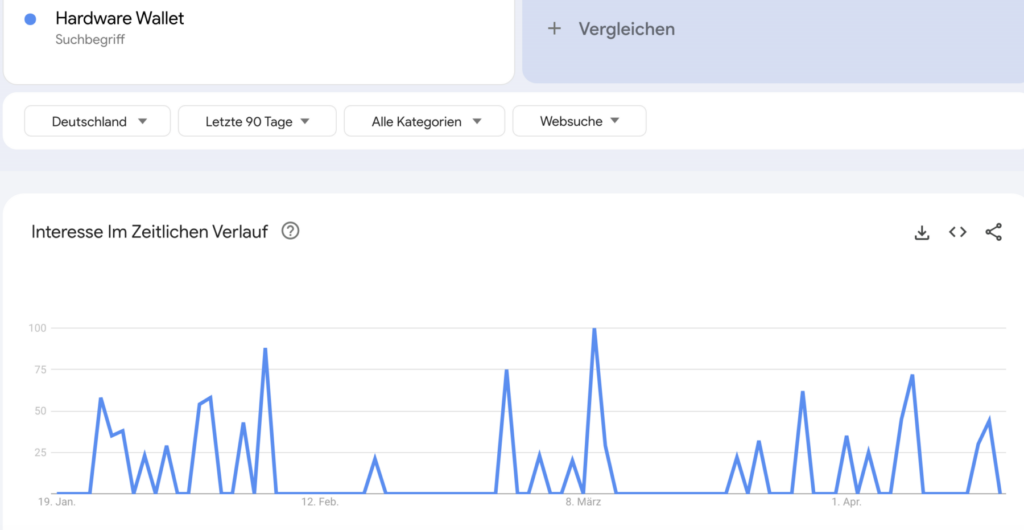How much money was captured?

The German crypto community
Between the end of 2021 and the end of 2022, the number of users and owners of cryptocurrencies in Germany increased by almost 1.3 million people.
According to Statista.com, 7.1 percent of the Germans held or acted at the end of 2022
Cryptocurrencies. This is an increase of 1.6 percent compared to the previous year.
The average German crypto user is male, between 18 and 34 years old and is considered to be well earned in the Federal Republic.
In 2021, in a survey, 67 percent of those surveyed who deal with cryptocurrencies had An annual income of at least 800,000 euros.
Hacker attacks, bankruptcy proceedings and similar incidents make the safe storage of coins essential.
Despite the negative headlines in the first quarter of this year, Binance is still the largest online wallet for storing cryptocurrencies in Germany, measured by the number of downloads, followed by Trust and the Newcomer Sweat Wallet.
In addition to the classic Exchanges, the average German crypto user also also includes Hardware-Wallets Asked how a quick look at the current Google trend reveals. According to the motto: not your keys, not your coins.

The dark side of the crypto world-crypto crime 2023
The term crypto crime describes criminal activities that are committed using cryptocurrencies such as Bitcoin, Ethereum or other digital assets. These activities range from money laundering to fraud towards theft and blackmail.
Combating crypto crime requires a deep understanding of the technology behind cryptocurrencies as well as the cooperation between governments, law enforcement authorities and the cryptocurrency industry.
Every year Chainalysis publishes the official crypto crime report with current figures on illegal activities around cryptocurrencies. The current report has now been published in spring 2023.


Solved by ransomware attacks drops by 40 percent
In 2022, the ransomware attacks were announced and that had an effect.
While around $ 765 million each captured in 2020 and 2021, it was only $ 457 million in 2022-a decline of $ 40 percent.
However, it is believed that the number of ransomware attacks has not decreased sharply, as the result suggests, but that there are more and more sacrificial organizations that vehemently refuse to pay ransomware attackers.
Bill Siegel from Coveware provided Chainalysis that shows that the victims' payment rates have dropped from 76 percent to only 41 percent since 2019.
Another interesting result of the report shows that the “lifespan” of ransomware has also dropped sharply since 2020.
While the average lifespan in 2020 was still 265 days, in 2022 it was only 70 days.
The experts see the reason for this in the efforts of the ransomware attackers to disguise their activities.
More and more attackers use or work with several ransomware strands at the same time that have a shorter lifespan.
Money laundering increases by 68 percent
Compared to 2021, there was an enormous increase in cryptocurrencies that were sent via illegal addresses last year.
A total of 23.8 billion US dollars were “washed” in 2022. This corresponds to an increase of 68 percent compared to the previous year.
As in previous years, the largest recipients of these illegal cryptocurrencies were the centralized mainstream exchanges.
This is remarkable, since these Exchanges usually have compliance measures to act against these activities, but also because these stock exchanges are coverage for fiat currencies on which illegal cryptocurrencies can be converted into cash.
But money laundering has not only increased through crypto exchanges. A trend has been recognizable since 2020 that illegal cryptocurrencies are also sold through Defi protocols. In 2022, this was almost 25 percent of all money laundering activities.
Another important finding from the observations of Chainalysis in connection with money laundering in 2022 concerns cryptocurrency mixers.
These were and are a popular veiling trick from cryptocriminals to hide the funds they send.
In May last year, two of these cryptocurrency mixers (Blender.io and Tornado Cash) from the OFAC were sanctioned for the first time because of their role in money laundering by cyber criminals.
The sanctioning of two very well-known cryptocurrency mixers resulted in the total amount of the cryptocurrencies sent to the mixers significantly decreased last year.
However, the value that is sent to the mixer now comes from illegal sources with a significantly greater probability.
While Mixer processed $ 11.5 billion in 2021, 10 percent of which came from illegal activities, in 2022 it was only $ 7.8 billion, of which 24 percent of which did not come from any legal sources.
Annual income from cryptocurrency fraud falls by 50 percent
Scam or fraud is and remains the greatest form of cryptocurrency crime.
Although annual income from cryptocurrency fraud by $ 10.9 billion has decreased to $ 5.9 billion, this is most likely due to the bear market.
Since the current prices for cryptocurrencies are very low, the fraud yield is automatically significantly lower than during the bullrun in 2021.
Even if the current fraud income is declining, there were numerous very successful scams in 2022.
The most lucrative was carried out by thehyper verses. This was classified as an investment fraud and earned the fraudsters $ 1.3 billion.
The Chainalysis report shows another interesting result if you look at the victim's average deposit amount according to the fraud type for 2022.
There are a total of five types of fraud: giveaway, imitation, investment, NFT and romantic fraud.
The average deposit amount of the victims for 2022 was as follows:
- “Giveaway”-threat: $ 1,834.21
- Subsequent fraud: $ 5,746.96
- Investment fraud: $ 995.82
- NFT fraud: $ 462.89
- Romantic fraud: $ 15,559
A guide to the respective fraud categories:
- GIVAWAY-RUG: The fraudsters ask their victims to send them cryptocurrencies and promise to send them more in return. Giveaway fraudsters often spend a prominent or acquaintances in order to give the promise of credibility.
- Subsequent fraud: The perpetrators pretend to be a person in a certain position, e.g. B. Finance officer or the like The victims are then informed that they have to deposit cryptocurrency to solve a problem, otherwise they will get into trouble.
- Investment fraud: The fraudsters promote a fake investment company that promises above -average returns.
- NFT fraud: The victims are tempted to buy fake NFTs that are similar to the well -known collections.
- Romantic fraud: The fraudsters pretend to build a romantic relationship with the victims in order to convince or persuade them to send them money.
2022-the most lucrative year for crypto hackers
2022 has probably been the most successful year for crypto hackers since the start of the recordings.
3.8 billion US dollars were stolen within 12 months. This is an increase of $ 0.5 billion compared to the previous year. Even though the number of hacks decreased per year.
There were still around 160 hacks a year in 2020 and an all -time high with 250 in 2021, there were only around 180 last year.
As in the previous year, the most affected and attacked platforms were the defi protocols with 82.1 percent.
This corresponds to a stolen total amount of $ 3.1 billion, and $ 3.1 billion was captured by cross-chain-bridge protocols alone.
Another popular goal of hacker attacks in 2022 was “Centralized Services” with around 20 percent.
By far the most productive hackers were cybercriminals with connections to North Korea last year.
In 2022 they broke their own record and captured $ 1.7 billion. (See 2021 with $ 429 million)





